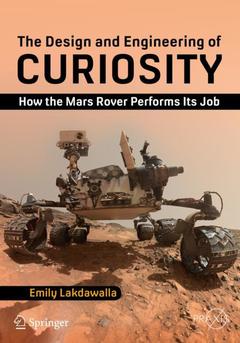Description
The Design and Engineering of Curiosity, 1st ed. 2018
How the Mars Rover Performs Its Job
Space Exploration Series
Author: Lakdawalla Emily
Language: English
Approximative price 34.80 €
In Print (Delivery period: 15 days).
Add to cartSupport: Print on demand
Description
/li>Contents
/li>Biography
/li>Comment
/li>
This book describes the most complex machine ever sent to another planet: Curiosity. It is a one-ton robot with two brains, seventeen cameras, six wheels, nuclear power, and a laser beam on its head. No one human understands how all of its systems and instruments work. This essential reference to the Curiosity mission explains the engineering behind every system on the rover, from its rocket-powered jetpack to its radioisotope thermoelectric generator to its fiendishly complex sample handling system. Its lavishly illustrated text explains how all the instruments work -- its cameras, spectrometers, sample-cooking oven, and weather station -- and describes the instruments' abilities and limitations. It tells you how the systems have functioned on Mars, and how scientists and engineers have worked around problems developed on a faraway planet: holey wheels and broken focus lasers. And it explains the grueling mission operations schedule that keeps the rover working day in and day out.
Dedication.- Foreword.- Acknowledgements.- Preface.- Chapter 1: Mars Science Laboratory.- Chapter 2: Getting to Mars.- Chapter 3: Mars Operations.- Chapter 4: How the Rover Works.- Chapter 5: SA/SPaH: Acquisition, Processing, and Handling.- Chapter 6: The Mast, Engineering Cameras, Navigation, and Hazard Avoidance.- Chapter 7: Curiosity's Science Cameras.- Chapter 8: Curiosity's Environmental Sensing Instruments.- Chapter 9: Curiosity's Chemistry Instruments.- Epilogue: Back on Earth.- Appendix.- About the Author.- Index.
Lakdawalla has been following the Mars Science Laboratory mission closely since its inception, attending all relevant public meetings, including the last three landing site selection meetings and frequently checking in on its progress from the observation deck over the clean room at JPL.
Based on interviews with the scientists and engineers who built and now operate the rover
Explains how the rover has actually functioned on Mars, including the wear on its components
Collects a wide variety of otherwise inaccessible information on rover engineering, including corrections to previously published work
Provides a one-of-a-kind reference to a mission that is likely to last for another decade at least, and which will need to onboard numerous scientists and engineers into operational roles
These books may interest you

Mars Science Laboratory 316.49 €



